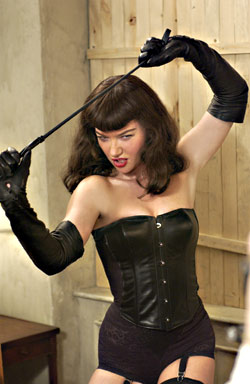In a remarkably stupid recent review in The New Yorker, Joan Acocella basically argued that the entire pinup tradition popularized by Hugh Hefner in the ’50s leads inexorably to today’s hard-core pornography, the abuse of children, the debasement of women, rape, and everything that is evil about the Internet (and probably the pop-up ads, too). I can only wonder what she’d make of The Notorious Bettie Page, which certainly leads to bigger things. As in Jesus Christ, our lord and savior. We’re talking about half-nude and occasionally naked young women, with their nether regions always strategically covered, lest U.S. postal authorities bust magazine gazers on federal obscenity charges, as often occurred before Playboy, Cosmo, the pill, hippies, the Summer of Love, Deep Throat, Erica Jong, and company made such issues moot.
Notorious, from American Psycho director Mary Harron, isn’t a particularly great or coherent movie, but it’s certainly timely during the new prurience-prudery debate. As third-wave feminist writers like Pamela Paul (Pornified) and Ariel Levy (Female Chauvinist Pigs) legitimately question the coarsening and commodification of female sexuality (see: Girls Gone Wild), Harron usefully reminds us that, 50 years ago, baring a little skin was a comparatively healthy thing. Or as Page (Gretchen Mol) puts it in her charming Tennessee accent while posing in a bikini on Coney Island (for an amateur photographer cop, no less), “Oh, what’s the harm in it?”
Struggling to make it as an actress, fresh off a bad marriage, sexually abused in her youth, Page isn’t presented as a feminist icon here—she reads Ecclesiastes, not Betty Friedan or Gloria Steinem. She’s a curious heroine in a curious movie—split between past (flashbacks to her childhood, youth, and pinup prime) and present (1955 Senate hearings chaired by Estes Kefauver, a role Harron wittily casts with David Strathairn—Murrow turned moron). Her letters home to a sister in Tennessee sound as corny as Dorothy in Kansas (the movie’s also somewhat randomly divided between color and black-and-white). Soon she’s happily agreeing to pose in bondage photos and films for the Klaws (siblings played by Lili Taylor and Chris Bauer). The whips, corsets, fetish boots, ropes, and gags would be disturbing in another context; here they’re like dress-up props from Page’s eager girlhood posing for the camera.
IS THIS OPPRESSION, or is this kitsch? That’s the distinction Acocella fails to make in The New Yorker. A Robert Mapplethorpe photograph or Jack Smith movie is just fine, because it’s gay—men playing dress up with other men. But can’t heterosexual men enjoy kitsch, too? When avid members of ’50s “camera clubs” book private sessions to release their shutters—and probably something else beneath their gabardines—at Page and her fellow models, there’s a kind of wholesome prurience to the proceedings. As she first removes her top for these nerds (a few lesbians among them), then her bottom, the movie suggests, she’s like an evangelist preaching her own sunny gospel. Proud of her body, Page enjoys a kind of open-air baptism, washing away the old taints inflicted upon her. “I’m not ashamed,” she says, citing Adam and Eve: “When they sinned, they put on clothes.”
Page’s no theologian, and Harron makes these sentiments as uncomplicated as a retouched photo: opaque, hidden, and possibly misleading. We know there’s more to Page, but Harron won’t show us— molested by her father, later juggling boyfriends in Manhattan and Miami, her sex life a mystery. Is she victim or victor? Notorious is a picture deliberately—and unsatisfactorily—framed by the quaint conventions of Page’s day, too flat and retro for its own good. Back then, we wouldn’t expect explicit scenes of sex (whether exploitation or enjoyment). Harron thinks it’s cute to mix stock footage of ’50s New York, frolicsome home movies (on the sets where the Klaws film S&M quickies like Sally’s Punishment), and voice-overs from Page and photographer Bunny Yeager (Sarah Paulson). Psychological realism isn’t her objective—she’s more like the Klaws than she knows. Page becomes another symbol, albeit a different symbol than she was for the men who perused spank mags like Wink, Whisper, Bachelor, Flirt, Titter, Eyeful, and She.
Why profile an enigma like Page and leave her, sphinxlike and saved, impenetrably clothed by her piety? Unlike that other early Playboy model, Marilyn Monroe, Page won’t be made tragic. She’s alive today at 83, three husbands behind her, a recluse and a cult figure since being rediscovered in the ’70s (she’s even got her own Web site, www.bettiepage.com, with photos for sale). Once deemed a threat to public morals—and, of course, children— during the Kefauver hearings, now she’s some sort of beloved icon with her black bangs and wink. The sex, scandal, and smut have been stripped away from her, leaving only the birthday suit. She reveals all, shows nothing.
Mol, of course, shows us everything— it’s a brave, cheerfully ingenuous performance, bringing this two-dimensional figure of eroto-nostalgia back to the pink. (In one of the film’s niftiest montages, she moves through a series of color magazine covers—she can’t be contained, it seems, by the Eisenhower frame of her day.) Yet no character but Page has much depth in Notorious; she’s all foreground, and everything else is just set dressing and props. Harron doesn’t even bother to name many characters, perhaps imagining we viewers are all cultists familiar with every intimate detail of Page’s biography. For younger moviegoers, she’s just another kitschy artifact of forgotten boomer desires—something saved in a shoebox in the back of Dad’s closet.
I’m not sure, however, that Harron attributes any great importance to Page. She’s a product of her tail-finned times, not the one who changed them. (And it would be overstating Hef’s influence to suggest that he did, either.) Unlike Acocella’s indictment of centerfold culture, Notorious relegates Page to the safety of the past; there is no tawdry legacy to smear her scrapbook. She remains pure because in her photos—unlike the faces of cyberporn—she’s looking right back at you, and her eyes aren’t dead.








